#chiromantis
Explore tagged Tumblr posts
Text



Southern or Grey Foam-nest Tree Frogs (Chiromantis xerampelina), family Rhacophoridae, South Africa
The adult females make a foam nest (from cloacal mucous), in a tree, bush or other vegetaion above water, in which they lay their eggs, which are then fertilized by the male. The tadpoles hatch from the eggs later, then drop down form the foam nest into the water below.
photographs: Imelus Umwabe, Lynn Raw, Arno Meintjes
#foam nest tree frog#tree frog#chiromantis#rhacophoridae#frog#amphibian#herpetology#animals#nature#africa
309 notes
·
View notes
Note
This might be a weird question but I can't think of a better person to ask! My nibling recently came out as non-binary and wants to change their name, but they're struggling to find something they are happy with.
They were given a feminine name at birth and are currently using a masculine name, but aren't happy with either of them. Every human name that's suggested to them is either too masc, too femme, or has poor associations. However, they love frogs, so I wondered if that might be a solution.
I've tried to find frog names that might work as a human name, but so far I'm not having much luck. It's not allowed to start with R or J, and apparently it's not allowed to have an X in it because nibling thinks they're "not cool enough" to carry that off (I've tried explaining that they're wrong, but 16 year olds are very sensitive).
If this isn't too weird a question, can you think of any frog or toad names that might be manageable as human names? We live in the UK for reference
So many thanks for even reading this giant info dump 💕
Wow this is only the second time I have gotten to help find a name for a human. What an honour.
Okay firstly, sounds 100% like your nibling is cool enough to use an X (despite my current negative emotions associated with the letter due to the Elongated Muskrat), and there are some *amazing* names out there with X's in, so they should at least consider them. Scinax and Ixalus for instance are great. Ixalus has a fun history: originally it was coined as a replacement name for Orchestes, which wasn't available because there was already a beetle genus called Orchestes. But then it turned out that Ixalus was *also* not available, because the world's most beautiful antelope, the bongo, was already called Ixalus. Only, the bongo had already been called Tragelaphus. So now Ixalus isn't the name used for *any* animal. Ixalus is Greek, meaning 'bounding, springing, spry'. Also there are numerous other frog genera that use the ending -ixalus, such as Heterixalus, Micrixalus, etc.
But, taking the lack of X seriously, here are some other alternatives. I will avoid names that are derived from other people's names, and focus on names that have a neutral ring to my ear, and are also euphonious (nice to say or hear) and fewer than four syllables. I am also only considering genus names, because there are too many species names to choose from:
Acris — meaning sharp, sour, bitter, pungent, sharp, keen, acute, energetic, eager, etc. Technically this is the feminine version of the adjective; the neuter version is Acre, but I do not think anyone would read 'Acris' and immediately think either gender. It is supposed to be pronounced with a long a, as in 'hard', but a lot of people pronounce it with a hard a as in 'ace'. This name is most familiar to Americans, because Acris are cricket frogs, widespread in the US.
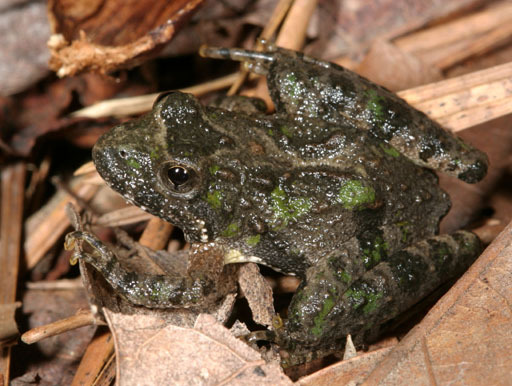
[Acris crepitans, src]
Mantis — of course, the genus Mantis was coined by Linnaeus in 1758, and so it is unambiguous that this is not a frog name. However, it is very often used as part of frog taxonomic names, such as Chiromantis, Boehmantis, Guibemantis, Gephyromantis, Phlyctimantis etc. Mantis is Greek (μάντης), and means oracle, prophet, soothsayer, seer, clairvoyant, or fortune teller. The name has the feminine gender in its language of origin, but that has no bearing on its use, which, barring the character in the Marvel movies, does not seem particularly gendered to me.
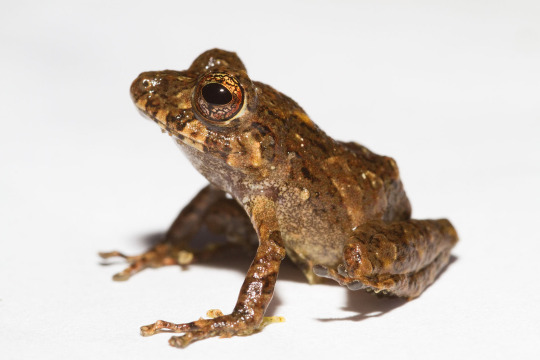
[Pristimantis cruentus, src]
Dasypops — simply a delightful name, but probably not neutral enough. I have not been able to figure out what the etymology is; it might be a play on Dasypus, the Greek word meaning 'rough-footed', which is a genus of armadillos. The frog is also spectacular, but there are no photos I can legally share on tumblr.
Kaloula — a euphonic name with an unclear meaning. Very round frogs. I love them.
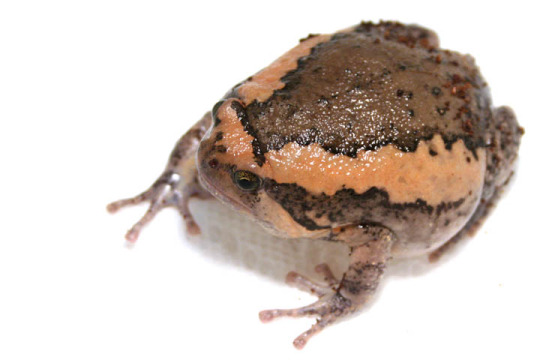
[Kaloula pulchra, src]
Adelotus — means 'unseen'. These are 'tusked frogs'. Males have crazy extensions of lower jaw bones, and they fight with them.
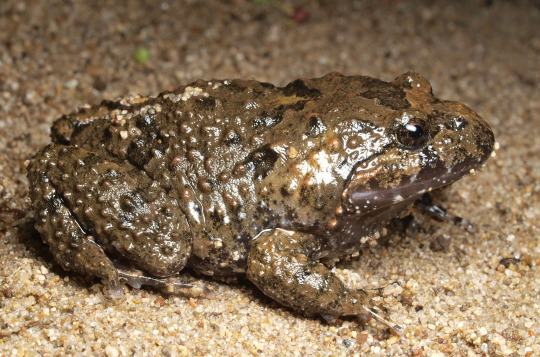
[Adelotus brevis, src]
Taruga — a Sanskrit name meaning 'tree climber'. I fucking love this name, and the frogs are just *chef's kiss* POINTY, and have really committed to bold colours.

[Taruga eques, src]
EDIT: I have been informed that taruga means ‘blockhead’ or ‘numb skull’ in Spanish, so it might not be the best choice. Sorry!
If the nibling would like to check out a list of genera themselves, there is a tolerably complete list here.
I hope this helps!
#frog#frogs#frogs and toads#names#animals#nonbinary#answers by Mark#annamelia-art#herpetology#I guess
744 notes
·
View notes
Text

frog asexual pride flag!
featuring: Leptobrachium lunatum Chiromantis xerampelina Phyllobates terribilis Nasikabatrachus sahyadrensis
#amphibians#amphibian#frogs#asexual#aroace#acespec#acesexual#ace#lgbt#pride#pride month#lgbt pride#lgbtqia#pride 2024#queer pride
6 notes
·
View notes
Text



Renata Mohlo
Elegante da morire
Baldini+Castoldi, Milano 2024, 192 pagine, brossura, ISBN 9791254941447
euro 18,00
email if you want to buy [email protected]
Milano, sbadata e rampante. Giorni nostri. Un cadavere giace nella toilette di un noto ristorante. L’acqua del rubinetto corre, il rotolo di carta igienica pure, e lo stiletto di una décolleté griffata affonda nel corpo esanime dell’illustre defunta. Lei, Madame Jesais Tout, ma all’anagrafe Gaetana Pizzuto; lei, direttrice onnipotente di una patinata rivista di moda, che decide ascese e cadute con un cenno del capo; lei, che «un tempo era buona, ma poi ha dimenticato tutto»; ebbene, lei ora viene avvolta in un tappeto afghano e chiusa nel freezer, per occultarne l’omicidio prima che la gente mormori. E quando Ignazio Scognamiglio, ispettore sgualcito e incline alla disfatta, sarà assoldato sottotraccia alla ricerca di colpevoli e moventi (a profusione), in passerella sfileranno rivalità antiche e figli rinnegati, portinaie chiromanti e parvenu dell’haute couture, fenomenologie del merletto e vendette servite gelide. Intessendo un noir che è anche satira tagliente, l’autrice realizza un affresco ironico e corale, quello della moda tutta brillio ma con i suoi chiaroscuri – lì dove «è tutto falso, la fantasia è altrove» – qui restituita con spensierata, ma a tratti tenera, efferatezza. Come si dice, «Adoro!»
Al piano di sotto
Quando un luogo banale diventa lo scenario di qualcosa di straordinario.
Tutto era dorato, ma era sorprendentemente argenteo quel che si vedeva dello stiletto in acciaio. Brillava superbo, illuminato dal raggio di luce che, penetrando da una feritoia in alto a sinistra, colpiva con precisione il tacco di una décolleté griffata. Una fibbia a forma di rondine, con la sua coda affusolata e biforcuta, giaceva un po’ più in là sul pavimento, mentre la punta della scarpa veniva inghiottita dal buio. Unico elemento vivido in quell’immensa scatola di marmo con venature ambrate, il rosso di un sottile rivolo di sangue che formava una chiazza frastagliata.
Gli specchi riflettevano ogni cosa all’infinito, in un gioco di rifrazioni che rasentava per perfezione quello delle piramidi, e il rumore dell’acqua, che sgorgava da un rubinetto d’oro dimenticato aperto, come una dolce reminiscenza orientale, si confondeva con i suoni sincopati di un pezzo di Dizzy Gillespie.
I soffitti alti e altrettanto specchiati moltiplicavano la scena: a terra giaceva un corpo elegante anche nella morte. Il tubino nero di YSL continuava imperterrito a fasciare un corpo inerme, minuto e in una posa scomposta. Come una farfalla trafitta da uno spillo, Madame Jesais Tout, la potente direttrice di «Cloud», aveva smesso di respirare. Era successo proprio mentre era in bagno, nel momento più intimo e riservato. Sembrava si volesse aggrappare alla carta igienica, che continuava a srotolarsi nella sua rosata ingenuità, producendo un ritmico cigolio. La porta era chiusa e chi avesse bussato sarebbe passato alla successiva pensando semplicemente che qualcuno si fosse asserragliato lì dentro per starsene un attimo in pace, per farsi di coca o per consumare una fugace avventura con uno degli aitanti camerieri. Le gambe piegate all’indietro, le braccia aperte a croce e i capelli di un rosso pompeiano lunghi di extension sparpagliati in ciocche disordinate, defunte già da tempo, enfatizzavano la perentorietà di tutta quella lussuosa pietra tombale, investita della responsabilità di conferire sacralità al luogo dove si fa pipì.
La scena poteva sembrare un’installazione dello Studio Azzurro. Un po’ macabra, certo, ma, si sa, il gusto dell’orrido aveva conquistato tutti e anche l’animo più sensibile aveva imparato a farci i conti. Si era ormai smesso di immaginare il bello per rallegrarsi, per elevarsi. Erano tempi duri. Tra gli stucchi dei salotti che contavano echeggiavano ancora le risate al ricordo della reazione di un giovane stilista, che, all’inaugurazione di una mostra, fu insultato da Klevis Klapman, fratello di Albin ed esponente della Young British Art. Il poveretto, di fronte a un manichino dall’aspetto efebico con un fallo piantato sulla fronte, aveva osato sorridere e sussurrare qualcosa tipo «Ma non ci credo!», scambiando un’occhiata d’intesa con un ragazzotto chinato ad armeggiare con una presa di corrente. Peccato che il ragazzotto fosse l’autore di quel capolavoro. Sollevando lo sguardo, gli avrebbe urlato «Sei davvero privo di fantasia!» di fronte al Gotha dell’arte e della moda che, all’unisono, si mise a fissare il poveruomo come se fosse un pipistrello morto caduto nella minestra. La sua carriera ovviamente finì lì, nessuno lo invitò più e così tornò a fare le pizze al paesello. Essere insultati pubblicamente da un artista d’avanguardia avrebbe rovinato chiunque.
Stupirsi o giudicare non era quindi chic. Il cinismo era quanto di più elegante ci fosse. Questa è la ragione per la quale quel delitto fu scoperto solo molte ore dopo dalla donna delle pulizie del più noto ristorante non solo della città, ma del mondo, perché apparteneva a uno degli stilisti più in voga.
03/05/24
1 note
·
View note
Text
Adattarsi ai cambiamenti è meglio che prevedere il futuro
Viviamo in un mondo in continua evoluzione che viaggia ad un ritmo sempre più veloce e ogni giorno ci troviamo ad affrontare nuove situazioni e sfide. Di fronte a queste difficoltà alcuni cercano di prevedere gli eventi futuri, una strategia che potrebbe andar bene più a chiromanti e guru del web. Certo, alcune situazioni possono essere in qualche misura previste, ma se fosse così facile,…
View On WordPress
0 notes
Photo

Spotted Bush Snake (Philothamnus semivariegatus) trying to eat a Foam Nest Frog (Chiromantis xerampelina).
Credit: Michael Flebbe
> For more pics, videos & articles visit: herpkeepers.com
#Philothamnus#Philothamnussemivariegatus#Chiromantis#Chiromantisxerampelina#herpkeepers#herps#snake#reptiles#wildlife#herpetology#animals#reptile#herp#snakes#wild#exotic#exoticpets#nature#naturelovers#biology#creatures#pet#pets#colubrid#colubridae#frog#frogs#amphibian#amphibians
38 notes
·
View notes
Text
Con Otelma al Quirinale
Con Otelma al Quirinale
Anna Lombroso per il Simplicissimus La crociata contro i bestemmiatori della Scienza, declinata in tutte le sue svariate discipline, deve essere condotta senza quartiere. L’anatema e l’ostracismo devono colpire tutti gli eretici, a cominciare dai più pericolosi, quelli che addirittura mettono in dubbio e abiurano alla loro stessa funzione etica e pedagogica al servizio di autorità che si…

Visualizza su WordPress
0 notes
Text










Sir David Attenborough as frogs 🐸
We 💚 you, David! Thanks for loving amphibians!
1. Strawberry Poison Frog (Oophaga pumilio) ©️Austin Penner
2. Blue Poison Dart Frog (Dendrobates tinctorius) ©️Frankfurt Zoo
3. Starry Night Harlequin Toad (Atelopus arsyecue) @fundacionatelopus
4. Blood Rain Frog (Pristimantis erythros) ©️F. Cisneros-Heredia
5. Polka-dot Treefrog (Boana punctata) ©️Dirk Ercken
6. African Gray Treefrog (Chiromantis xerampelina) ©️Ton Rulkens
7. American Toad (Anaxyrus americanus) ©️Ed Schneider
8. Golden Toad (Incilius periglenes) ©️Charles H. Smith
9. Red-eyed Treefrog (Agalychnis callidryas) ©️Geoff Gallice
11. Harlequin Toad (Atelopus cf. hoogmoedi) ©️Daniela Rößler
249 notes
·
View notes
Text
An egg is an organic vessel grown by an animal to carry a possibly fertilized egg cell (a zygote) and to incubate from it an embryo within the egg until the embryo has become an animal fetus that can survive on its own, at which point the animal hatches.
Most arthropods, vertebrates (excluding live-bearing mammals), and mollusks lay eggs, although some, such as scorpions, do not.
Reptile eggs, bird eggs, and monotreme eggs are laid out of water and are surrounded by a protective shell, either flexible or inflexible. Eggs laid on land or in nests are usually kept within a warm and favorable temperature range while the embryo grows. When the embryo is adequately developed it hatches, i.e., breaks out of the egg's shell. Some embryos have a temporary egg tooth they use to crack, pip, or break the eggshell or covering.
The largest recorded egg is from a whale shark and was 30 cm × 14 cm × 9 cm (11.8 in × 5.5 in × 3.5 in) in size.[1] Whale shark eggs typically hatch within the mother. At 1.5 kg (3.3 lb) and up to 17.8 cm × 14 cm (7.0 in × 5.5 in), the ostrich egg is the largest egg of any living bird,[2] though the extinct elephant bird and some non-avian dinosaurs laid larger eggs. The bee hummingbird produces the smallest known bird egg, which weighs half of a gram (around 0.02 oz). Some eggs laid by reptiles and most fish, amphibians, insects, and other invertebrates can be even smaller.
Reproductive structures similar to the egg in other kingdoms are termed "spores," or in spermatophytes "seeds," or in gametophytes "egg cells".
The most common reproductive strategy for fish is known as oviparity, in which the female lays undeveloped eggs that are externally fertilized by a male. Typically large numbers of eggs are laid at one time (an adult female cod can produce 4–6 million eggs in one spawning) and the eggs are then left to develop without parental care. When the larvae hatch from the egg, they often carry the remains of the yolk in a yolk sac which continues to nourish the larvae for a few days as they learn how to swim. Once the yolk is consumed, there is a critical point after which they must learn how to hunt and feed or they will die.
A few fish, notably the rays and most sharks use ovoviviparity in which the eggs are fertilized and develop internally. However, the larvae still grow inside the egg consuming the egg's yolk and without any direct nourishment from the mother. The mother then gives birth to relatively mature young. In certain instances, the physically most developed offspring will devour its smaller siblings for further nutrition while still within the mother's body. This is known as intrauterine cannibalism.
In certain scenarios, some fish such as the hammerhead shark and reef shark are viviparous, with the egg being fertilized and developed internally, but with the mother also providing direct nourishment.
The eggs of fish and amphibians are jellylike. Cartilaginous fish (sharks, skates, rays, chimaeras) eggs are fertilized internally and exhibit a wide variety of both internal and external embryonic development. Most fish species spawn eggs that are fertilized externally, typically with the male inseminating the eggs after the female lays them. These eggs do not have a shell and would dry out in the air. Even air-breathing amphibians lay their eggs in water, or in protective foam as with the Coast foam-nest treefrog, Chiromantis xerampelina.
Bird eggs
Main article: Bird egg
Bird eggs are laid by females and incubated for a time that varies according to the species; a single young hatches from each egg. Average clutch sizes range from one (as in condors) to about 17 (the grey partridge). Some birds lay eggs even when not fertilized (e.g. hens); it is not uncommon for pet owners to find their lone bird nesting on a clutch of unfertilized eggs, which are sometimes called wind-eggs.
The default color of vertebrate eggs is the white of the calcium carbonate from which the shells are made, but some birds, mainly passerines, produce colored eggs. The pigment biliverdin and its zinc chelate give a green or blue ground color, and protoporphyrin produces reds and browns as a ground color or as spotting.
Non-passerines typically have white eggs, except in some ground-nesting groups such as the Charadriiformes, sandgrouse and nightjars, where camouflage is necessary, and some parasitic cuckoos which have to match the passerine host's egg. Most passerines, in contrast, lay colored eggs, even if there is no need of cryptic colors.
However some have suggested that the protoporphyrin markings on passerine eggs actually act to reduce brittleness by acting as a solid-state lubricant.[10] If there is insufficient calcium available in the local soil, the egg shell may be thin, especially in a circle around the broad end. Protoporphyrin speckling compensates for this, and increases inversely to the amount of calcium in the soil.[11]
For the same reason, later eggs in a clutch are more spotted than early ones as the female's store of calcium is depleted.
The color of individual eggs is also genetically influenced, and appears to be inherited through the mother only, suggesting that the gene responsible for pigmentation is on the sex-determining W chromosome (female birds are WZ, males ZZ).
It used to be thought that color was applied to the shell immediately before laying, but subsequent research shows that coloration is an integral part of the development of the shell, with the same protein responsible for depositing calcium carbonate, or protoporphyrins when there is a lack of that mineral.
In species such as the common guillemot, which nest in large groups, each female's eggs have very different markings, making it easier for females to identify their own eggs on the crowded cliff ledges on which they breed.
Shell
Bird eggshells are diverse. For example:
cormorant eggs are rough and chalky
tinamou eggs are shiny
duck eggs are oily and waterproof
cassowary eggs are heavily pitted
Tiny pores in bird eggshells allow the embryo to breathe. The domestic hen's egg has around 7000 pores.[12]
Some bird eggshells have a coating of vaterite spherules, which is a rare polymorph of calcium carbonate. In Greater Ani Crotophaga major this vaterite coating is thought to act as a shock absorber, protecting the calcite shell from fracture during incubation, such as colliding with other eggs in the nest.[13]
Most bird eggs have an oval shape, with one end rounded and the other more pointed. This shape results from the egg being forced through the oviduct. Muscles contract the oviduct behind the egg, pushing it forward. The egg's wall is still shapeable, and the pointed end develops at the back. Long, pointy eggs are an incidental consequence of having a streamlined body typical of birds with strong flying abilities; flight narrows the oviduct, which changes the type of egg a bird can lay.[14] Cliff-nesting birds often have highly conical eggs. They are less likely to roll off, tending instead to roll around in a tight circle; this trait is likely to have arisen due to evolution via natural selection. In contrast, many hole-nesting birds have nearly spherical eggs.[15]
Predation
Many animals feed on eggs. For example, principal predators of the black oystercatcher's eggs include raccoons, skunks, mink, river and sea otters, gulls, crows and foxes. The stoat (Mustela erminea) and long-tailed weasel (M. frenata) steal ducks' eggs. Snakes of the genera Dasypeltis and Elachistodon specialize in eating eggs.
Brood parasitism occurs in birds when one species lays its eggs in the nest of another. In some cases, the host's eggs are removed or eaten by the female, or expelled by her chick. Brood parasites include the cowbirds and many Old World cuckoos.
Like amphibians, amniotes are air-breathing vertebrates, but they have complex eggs or embryos, including an amniotic membrane. Amniotes include reptiles (including dinosaurs and their descendants, birds) and mammals.
Reptile eggs are often rubbery and are always initially white. They are able to survive in the air. Often the sex of the developing embryo is determined by the temperature of the surroundings, with cooler temperatures favouring males. Not all reptiles lay eggs; some are viviparous ("live birth").
Dinosaurs laid eggs, some of which have been preserved as petrified fossils.
Among mammals, early extinct species laid eggs, as do platypuses and echidnas (spiny anteaters). Platypuses and two genera of echidna are Australian monotremes. Marsupial and placental mammals do not lay eggs, but their unborn young do have the complex tissues that identify amniotes.
Mammalian eggs
The eggs of the egg-laying mammals (the platypus and the echidnas) are macrolecithal eggs very much like those of reptiles. The eggs of marsupials are likewise macrolecithal, but rather small, and develop inside the body of the female, but do not form a placenta. The young are born at a very early stage, and can be classified as a "larva" in the biological sense.[16]
In placental mammals, the egg itself is void of yolk, but develops an umbilical cord from structures that in reptiles would form the yolk sac. Receiving nutrients from the mother, the fetus completes the development while inside the uterus.
Evolution and structure
All sexually reproducing life, including both plants and animals, produces gametes. The male gamete cell, sperm, is usually motile whereas the female gamete cell, the ovum, is generally larger and sessile. The male and female gametes combine to produce the zygote cell. In multicellular organisms the zygote subsequently divides in an organised manner into smaller more specialised cells, so that this new individual develops into an embryo. In most animals the embryo is the sessile initial stage of the individual life cycle, and is followed by the emergence (that is, the hatching) of a motile stage. The zygote or the ovum itself or the sessile organic vessel containing the developing embryo may be called the egg.
A recent proposal suggests that the phylotypic animal body plans originated in cell aggregates before the existence of an egg stage of development. Eggs, in this view, were later evolutionary innovations, selected for their role in ensuring genetic uniformity among the cells of incipient multicellular organisms.[17]
Formation
The cycle of the egg's formation is started by the gamete ovum being released (ovulated) and egg formation being started. The finished egg is then ovipositioned and eventual egg incubation can start.
Scientific classifications
Scientists often classify animal reproduction according to the degree of development that occurs before the new individuals are expelled from the adult body, and by the yolk which the egg provides to nourish the embryo.
Egg size and yolk
Vertebrate eggs can be classified by the relative amount of yolk. Simple eggs with little yolk are called microlecithal, medium-sized eggs with some yolk are called mesolecithal, and large eggs with a large concentrated yolk are called macrolecithal.[7] This classification of eggs is based on the eggs of chordates, though the basic principle extends to the whole animal kingdom.
Microlecithal

Microlecithal eggs from the roundworm Toxocara

Microlecithal eggs from the flatworm Paragonimus westermani
Small eggs with little yolk are called microlecithal. The yolk is evenly distributed, so the cleavage of the egg cell cuts through and divides the egg into cells of fairly similar sizes. In sponges and cnidarians the dividing eggs develop directly into a simple larva, rather like a morula with cilia. In cnidarians, this stage is called the planula, and either develops directly into the adult animals or forms new adult individuals through a process of budding.[18]
Microlecithal eggs require minimal yolk mass. Such eggs are found in flatworms, roundworms, annelids, bivalves, echinoderms, the lancelet and in most marine arthropods.[19] In anatomically simple animals, such as cnidarians and flatworms, the fetal development can be quite short, and even microlecithal eggs can undergo direct development. These small eggs can be produced in large numbers. In animals with high egg mortality, microlecithal eggs are the norm, as in bivalves and marine arthropods. However, the latter are more complex anatomically than e.g. flatworms, and the small microlecithal eggs do not allow full development. Instead, the eggs hatch into larvae, which may be markedly different from the adult animal.
In placental mammals, where the embryo is nourished by the mother throughout the whole fetal period, the egg is reduced in size to essentially a naked egg cell.
Mesolecithal

Frogspawn is mesolecithal.
Mesolecithal eggs have comparatively more yolk than the microlecithal eggs. The yolk is concentrated in one part of the egg (the vegetal pole), with the cell nucleus and most of the cytoplasm in the other (the animal pole). The cell cleavage is uneven, and mainly concentrated in the cytoplasma-rich animal pole.[3]
The larger yolk content of the mesolecithal eggs allows for a longer fetal development. Comparatively anatomically simple animals will be able to go through
3 notes
·
View notes
Text
Grey Foam Nesting Frog,(Chiromantis xerampelina)
Also known as the Grey Tree frog as these frogs are arboreal (they live in trees), the foam ball is the nest of the Foam Nest Frog - the nests are formed as females secrete a fluid from the oviduct, which the froth into a foam, before laying eggs inside, males will join by adding sperm into the nest.
The Foam dries and hardens protecting the eggs from drought or predators,tadpoles hatch between 4 to 5 days - dropping into the water where they continue their life sickles.
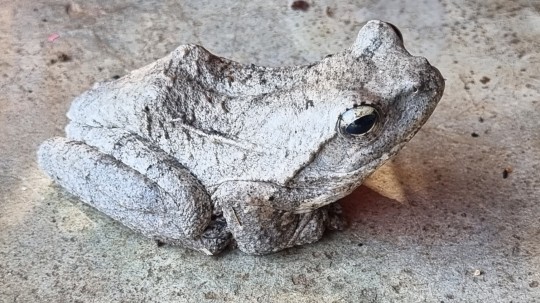
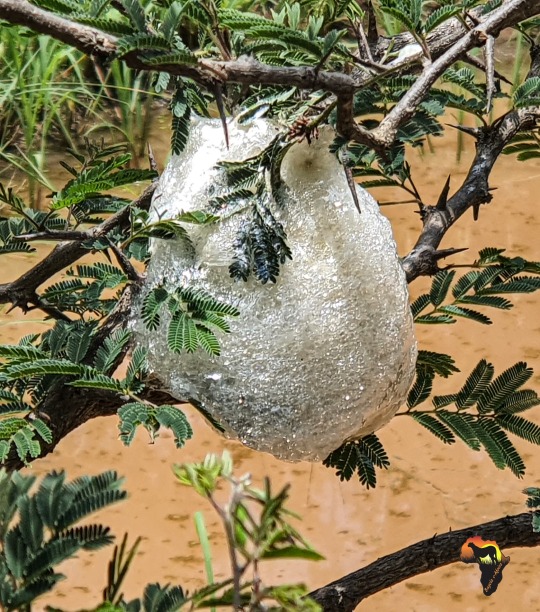

#safari#nature#wildlifephotography#underafricanskies#buyelaeafrica#wildlife#fieldguide#thisisafrica#facts#conservation#returntoafrica#amphibians
2 notes
·
View notes
Text
*Lucifero prende in giro suo fratello maggiore Michael dimostrando a lui che è molto debole insieme al suo Dio e ride molto divertito per tutto quello che ha fatto e gli dimostra anche che ha molti seguaci
– La particola alla mano, così posso calpestare il vostro Dio, quel Dio che io ho ucciso; e posso celebrare le mie messe (le messe nere) con i miei Sacerdoti che ho strappato a Lui…
– I Preti vestiti come netturbini, camuffati; così li porto dove voglio io, negli alberghi e nelle case private, in cerca di donne e di omosessuali e faccio commettere tanti sacrilegi e li porto nel mio regno! Quanti, quanti Preti mimetizzati sono nel mio regno! E non mi scapperanno più (risate forti…).
– I Preti e i Vescovi iscritti alla massoneria e alle mie sette…oh quanti, oh quanti ce ne porto col denaro e con le donne…quanti, quanti diventano miei amici fedeli…col denaro e con le donne…ne prendo quanti ne voglio, li porto nel mio regno.
– Le gonne corte, con le quali accalappio uomini e donne e riempio il mio regno (risate lunghe…sganasciate); che contento…che gioia…che contento…
– La televisione…uh, la televisione…è il mio apparecchio, l’ho inventato io…, per distruggere le singole anime e le famiglie…le separo, le disgrego con programmi miei, sottilissimi e penetranti…uh, la televisione è il centro di attrazione dove attiro anche tanti Preti, frati e suore, specialmente nelle ore piccole e poi non li faccio più pregare: ahahahahahah…In un attimo mi presento in tutto il mondo…mi ascoltano e mi vedono tutti…mi aiutano assai bene i miei fedeli servi, i maghi, le streghe, cartomanti, chiromanti, astrologi…ahahah ahahah…!
– Le discoteche…che bello…sono i miei palazzi d’oro dove attiro le migliori speranze della società, che io faccio mie, distruggendo le loro anime e i loro corpi…quante migliaia e migliaia ne porto con me con l’alcool, con la droga e col sesso…oh, che continua mietitura…Le ho affidate a tanti politici, i miei fedeli servi, e consacrati…lo sono il vero re del mondo, e non già il vostro Dio, che io ho crocifisso.
– Il divorzio…la separazione degli sposi, sono stati inventati da me; ne rivendico la proprietà…E’ una delle mie più intelligenti scoperte…così distraggo la famiglia e distruggo la società, dove io sono adorato come vero re del mondo…Il sesso…il sesso…non ascoltate quell’uomo impiccato in croce che non vi dà niente, il vero piacere…il vero piacere ve lo do soltanto col sesso libero…il mio regno è soprattutto libertà del piacere sessuale, con cui regno sulla terra.
– L’aborto…l’uccisione degli innocenti…oh…urrah! urrah! È stata la mia trovata più bella e più gustosa! Ammazzare gli innocenti invece dei colpevoli e degli omicidi della mafia! Distruggo l’umanità e così finiscono, prima di nascere, gli adoratori del vostro falso Dio…urrah…urrah…
– La droga…è il cibo più gustoso che io faccio mangiare ai giovani per renderli pazzi…e così ne faccio quello che voglio…ladri…assassini…lussuriosi…feroci come me…dominatori del mondo…miei ministri.
– Ma soprattutto mi piacciono e mi rallegrano quegli ecclesiastici che negano la mia esistenza e la mia opera nel mondo…e sono tantissimi…oh, che gioia, che gioia per me…lavoro tranquillo e sicuro…persino i teologi oggi non credono nella mia esistenza…che bello…che gioia…e così negano anche quel loro Dio che era venuto per distruggermi…invece l’ho vinto…l’ho inchiodato io sulla Croce…ahahahah…!
Bravi questi Preti…bravissimi questi Vescovi…bravissimi questi teologi sono tutti i miei fedeli servi torelli…ne faccio quello che voglio ahahahaha…! Ormai sono miei…li porto dove voglio…vestiti da beccamorti…con la sigaretta sempre in bocca…profumati come gagà…in cerca di donnicciole facili…con auto di ultima moda…pieni di danaro…si ribellano ai dogmi del loro falso Dio…e della falsa Chiesa di quel Crocifisso mia vittima…sono i miei soldati più sicuri del mio regno, pieno pieno di loro…Con essi metto confusione e smarrimento nel popolo, che allontano sempre più dal falso Dio…e porto nel mio regno di odio e di disperazione eterna…per sempre con me, con me…hahahahaha!
Quanti di essi ne ho fatti iscrivere alle sette mie allettati dalla mia carriera e dal mio denaro…li compro con facilità perché finalmente sono riuscito a non far amare più, quel falso loro Dio; né quella Donna che pretende di avermi vinto…”.*

16 notes
·
View notes
Text
Curiosità
Forse non sono stato attento: quanti, fra veggenti, astrologi e chiromanti, avevano predetto l’epidemia?
Hollander
2 notes
·
View notes
Text
"Due visi pallidi,mani gelate coi tuoi occhi grandi,leggimi la mente come i chiromanti"
6 notes
·
View notes
Text
0 notes
Text
Quarzo

quarzo #51484F
Il colore quarzo è quello del quarzo, in genere traslucido e pallido, ma anche con tonalità accese. Gli antichi romani utilizzavano il quarzo rosa come cicatrizzante dopo avere esposto dei pezzi del minerale al sole. Nel Medioevo veniva usato dai chiromanti per prevedere il futuro.
quarzo rosa (crayola) #BD559C
quarzo rosato (pantone) #F7CAC9
quarzo corallo (pantone) #F77464
quarzo pesca (pantone) #F5B895
grigio quarzo (ral) #6B695F
quarzo blu (pantone) #274374
quarzo violetto (pantone) #8B4963
quarzo rosa (pantone) #EFA6AA
0 notes
Text
Con Otelma al Quirinale
Con Otelma al Quirinale
Anna Lombroso per il Simplicissimus La crociata contro i bestemmiatori della Scienza, declinata in tutte le sue svariate discipline, deve essere condotta senza quartiere. L’anatema e l’ostracismo devono colpire tutti gli eretici, a cominciare dai più pericolosi, quelli che addirittura mettono in dubbio e abiurano alla loro stessa funzione etica e pedagogica al servizio di autorità che si…

View On WordPress
0 notes